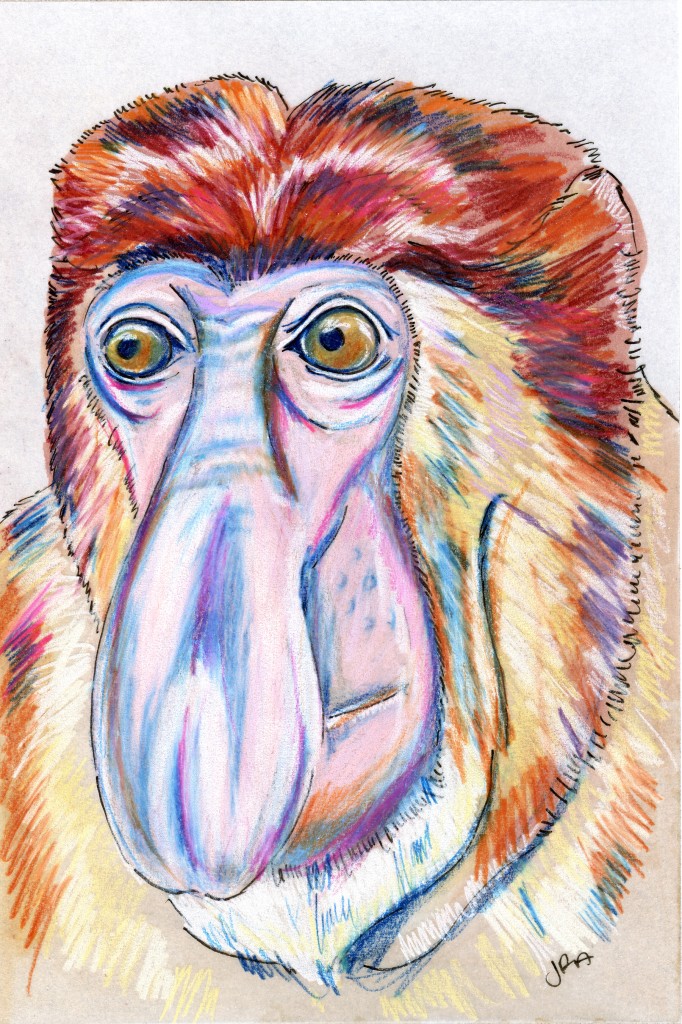Proboscis Monkey (Nasalis larvatus)
Well, here’s a good opposites-attract companion for yesterday’s tiny-nosed Tonkin snub: the proboscis monkey, which lives only in Borneo. You will have noticed his floppy nose (and it’s only the males who have such gigantic honkers), but you probably don’t want to stare. It’s okay: I bet this monkey feels about his schnozz the same way Edmond Rostand’s Cyrano felt about his: “…[B]e it known to you that I am proud, proud of such an appendage! inasmuch as a great nose is properly the index of an affable, kindly, courteous [mammal], witty, liberal, brave, such as I am!”
The proboscis monkey is not only witty and brave (maybe). It’s also a good swimmer, a skilled diver, and a maker of distinctive sounds variously described as howls, growls, or honks. Sadly, it’s quite endangered, too, thanks to traditional medicine, the bushmeat trade, and habitat destruction: the usual suspects.
I think these monkeys are quite charming with an endearing look to them, but the most common word the 19th- and early 20th-century naturalists used to describe them was “grotesque.” Here are some passages you may enjoy.
From The Naturalist’s Library by William Jardine, 1833:
“This singular monkey is at once distinguished by the extraordinary elongation of the nose, which is nearly four inches in length, and gives a grotesque appearance to the animal, at the same time far from pleasing.”
From The Living World by James William Buel, 1891:
“The Proboscis Monkey…resembles a shrivelled, bowed, long-nosed, little old man or woman, and is sacred in the eyes of the natives. Its noisy outcries, malignant disposition and fondness for irritating mischief, seem to add a fresh illustration to the truth that the uncivilized animal nature is perfectly unfit for the government of self or of others.”
From The Evolution of Man by Ernst Haeckel, 1903:
“…the well-shaped nose of which might well be coveted by men in whom this organ is too short. On comparing the face of this nosed monkey with that of specially ape-like human beings (e.g., the noted Julia Pastrana, Fig. 126), the former will appear a higher form of development than the latter. There are many persons who believe that the ‘image of God’ is unmistakably reflected in their own features. If the Nosed-ape shared in this singular opinion, he would hold it with a better right than some snub-nosed people.”
Finally, an illustration from the first book quoted above, The Naturalist’s Library (1833) by William Jardine. I love this illustration.



That illustration is fantastically creepy.
You mean William Jardine’s, right? Isn’t it, though? But also kind of cute in a way. Such a funny expression on his face.
Early naturalists sometimes seem very unimpressed by the wonders of nature. Here’s Mary Kingsley on gorillas:
“I have no hesitation in saying that the gorilla is the most horrible wild animal I have seen. I have seen at close quarters specimens of the most important big game of Central Africa and, with the exception of snakes, I have run away from all of them; but although elephants, leopards and pythons give you a feeling of alarm, they do not give that feeling of horrible disgust that an old gorilla gives on account of its hideousness of appearance.”
Any thoughts on why they would see fit to be so harsh about God’s creations? And are there any naturalists particularly known for their affection towards all creatures?
Good questions, Clare. I don’t know of any affectionate naturalists, but surely there are some. I’ll let you know if I run across any, and will you do the same for me?
I’m also not sure how to account for the harshness of their language. On the one hand, it’s vivid to complement their drawings; they didn’t have photos or films to share with us. But on the other hand, it would be possible to be vivid without calling the animals you’re observing “vile” or “horrible”! It’s so judgmental! Maybe it’s all just wrapped up in romantic dichotomies of nature: wild/pure, scary/beautiful. What do you think?